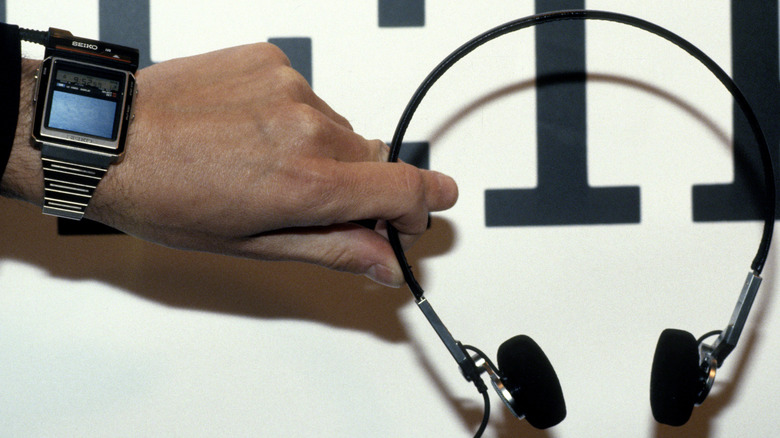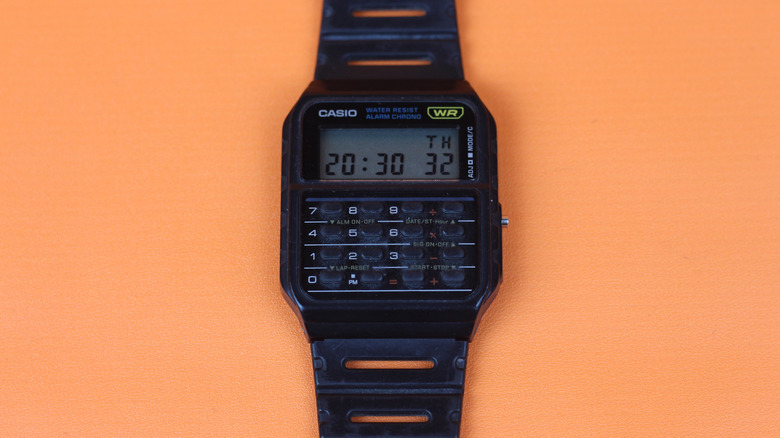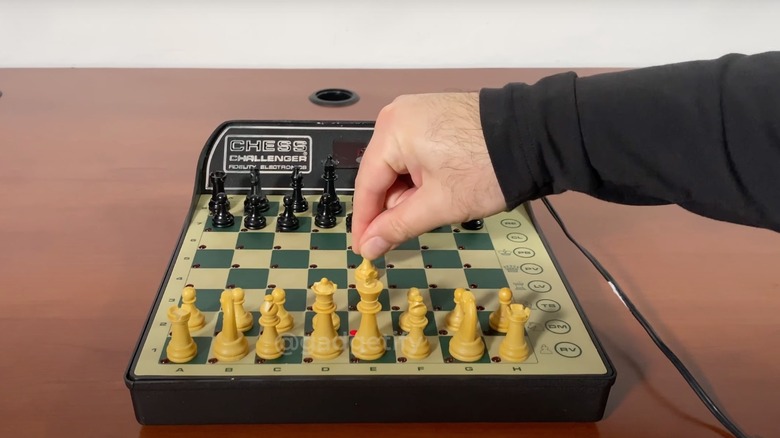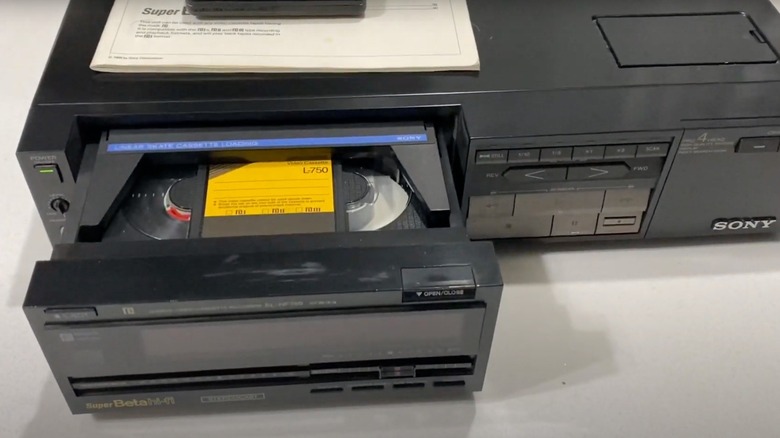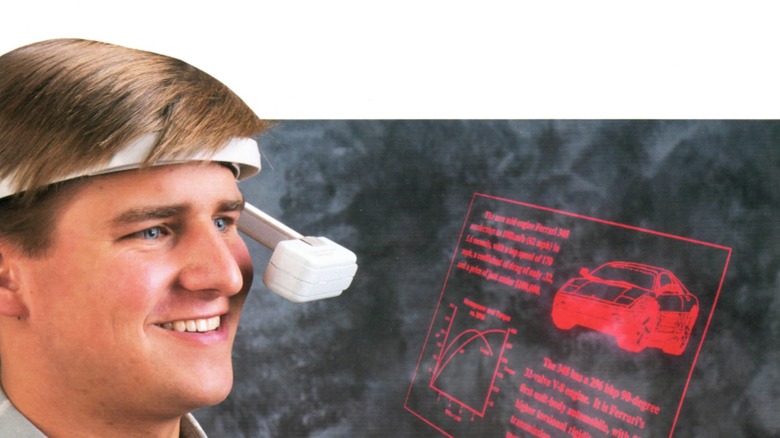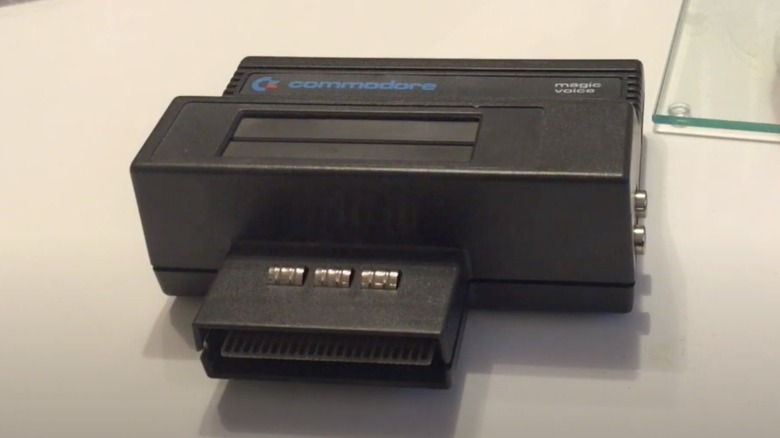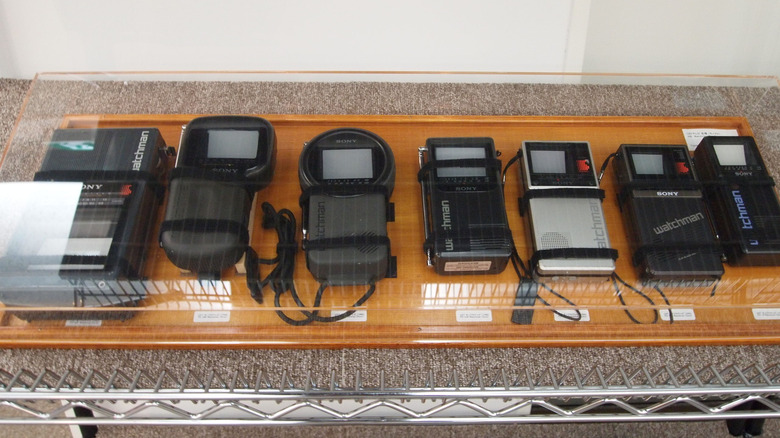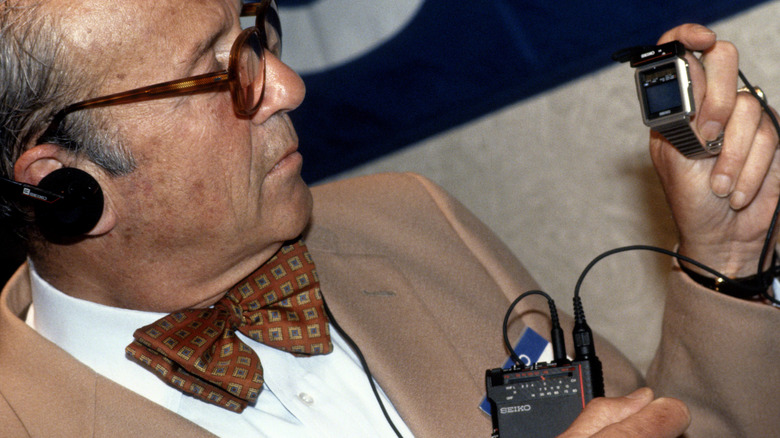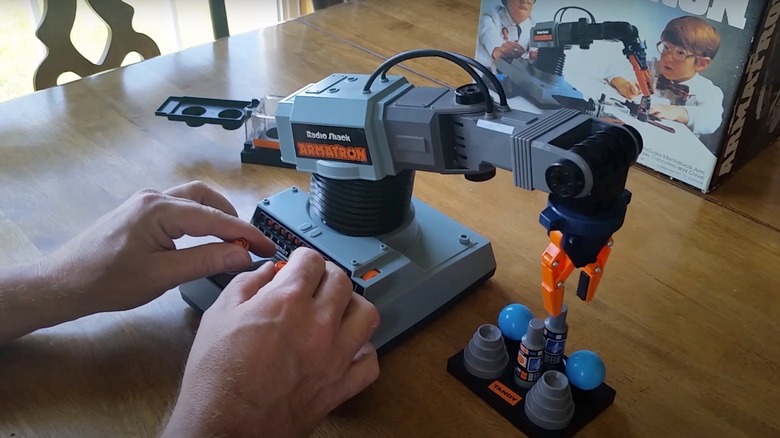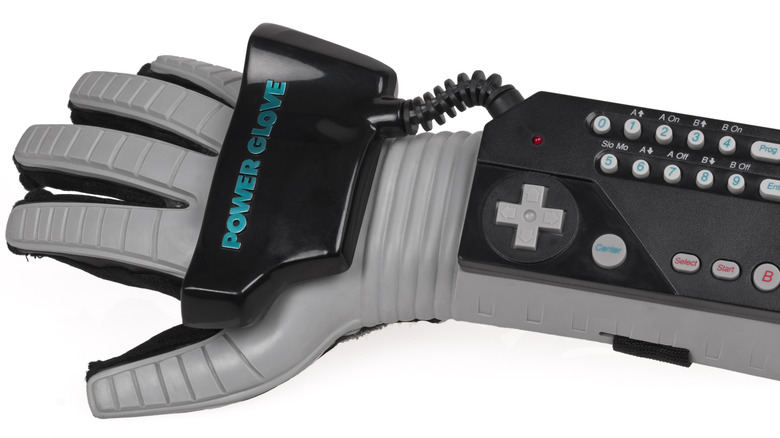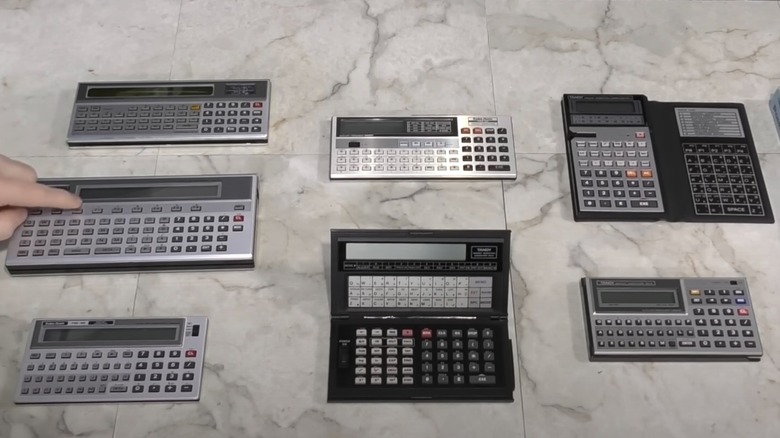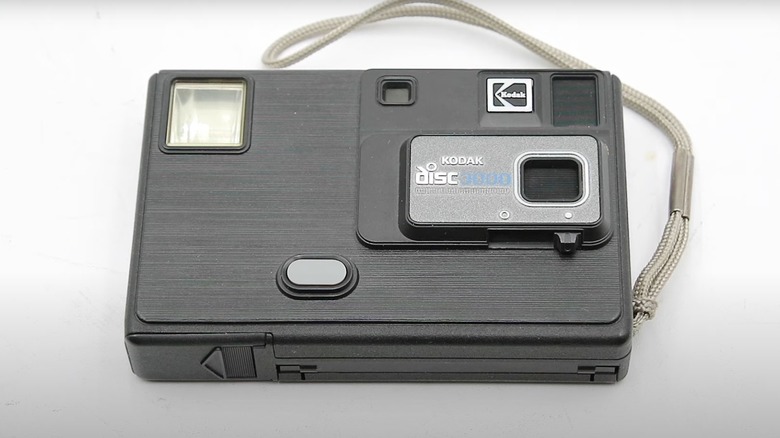12 Of The Weirdest Gadgets Sold In The 1980s
We may receive a commission on purchases made from links.
The 1980s was arguably the coolest decade of the 20th century. If it wasn't the wacky, colorful fashion, then it was the movies and the music — not to mention the gadgets. In the '80s, people thought they were only a hop, skip, and a leap away from a sci-fi future; just look at how many books and movies from the time have a "futuristic" setting with laser guns and flying cars in the early 2000s. Perhaps some truly believed they'd be watching television on holograms and using robot assistants soon, and so to lay the groundwork for that world, we got some fascinatingly bizarre tech gadgets.
You already know about the Walkmans, bulky cell phones, and early personal computers, but lost in the cracks were things like the Audio Technica Sound Burger, a supposedly portable vinyl record player. Stuff that was just weird and never caught on, a use case worth the price, or perhaps was just too far ahead of its time. We are looking at those things. Here are 12 gadgets from the 80s that may not always go down in history, but certainly raise an eyebrow.
Casio Calculator Watch
The Casio Calculator Watch (specifically the CA series) is exactly what it sounds like: a miniature calculator in a watch format. Most remember it as the watch worn by Marty McFly in the classic "Back to the Future" movies. It's not the first of its kind, as there were already luxury calculator watches in the '70s. However, it was still quite impressive tech for the time to pack a calculator into such a small form factor, and it came on the heels of the quartz piezoelectric timepiece revolution. More than that, though, it was fashionable to look geeky in the '80s. People wanted to look like Marty McFly, and many celebrities since have worn them to chase trends
Of course, you can probably imagine it's not the most convenient way to use a calculator when the buttons are so small that you need the edge of a fingernail to press them. They might be nifty for a quick, back-of-the-napkin calculation, but not much more than that. No one is going to be using this to do their homework or to run orbital calculations for a rocket in place of an actual calculator. Still, you can buy a brand-new Casio calculator watch today. With the popularity of the Apple Watch, though — which can do way more than just calculations — the former is naturally going to remain a concluded chapter in history.
Chess Challenger
Long before a computer trounced world champion chess legend Gary Kasparov, there was the Chess Challenger. Multiple iterations were manufactured across the years, but the premise is simple: Chess Challenger is an electronic chessboard that lets you play against an algorithmic opponent. YouTuber Gadgetify demonstrates the magnetized chess board by making their play on squares that have flashing red lights. The computer opponent then flashes a light under the chess piece it wishes to move and the location it wishes to move it to. With that, you always have an opponent to play with.
Believe it or not, there were even chess championships between chess-playing computers like the Challenger. In 1980, the Challenger won first place in the 1st World Microcomputer Chess Championship. Knowing how digital chess is played these days, though, you can probably guess what the fate of the Chess Challenger was.
By 1986, programs like Chessmaster were already on the market for PCs of the time, like the Commodore 64 or the Amiga, and online PVP chess games would arrive by 1992. Kasparov was defeated in 1997 by Deep Blue, and in the modern era, just about every computer has a default chess game program squirreled away somewhere. Anyone can play chess with a real or AI opponent on their phone, for free, so Chess Challenger and its kin will remain curious artifacts.
Super Betamax
Before DVDs and video streaming, there was VHS, one of the most important developments of the 1980s. However, the VHS had a fierce competitor in Sony's Betamax. To give an analogy, this was like the rivalry between HD DVDs and Blu-ray back in the day. Two competing formats that required their own respective hardware — you couldn't play an HD DVD on a Blu-ray player and vice versa — but functionally did the same thing. Betamax was the hi-fi option, boasting better image quality than its competitor, although this resulted in a smaller capacity. If you know what happened to HD DVD, then you can figure out how this story ends.
Betamax could not overcome VHS, so in a last ditch effort, it released SuperBeta, which had better quality than ever before, but required a new SuperBeta machine to go with it. Consumers weren't likely all that enthused about having to invest in a new machine, especially since most folks at the time didn't have hardware that could reproduce a Betamax in its full glory, much less a SuperBeta. Curiously enough, Sony continued to support the format long after VCR won — it was selling the tape recording hardware until 2002, and only stopped shipping Betamax cassettes in 2016.
The Clapper
The 1980s had its own version of a smart home, but it wasn't a voice-activated digital assistant — it was a plug-in device that allowed you to switch things on and off by clapping your hands. The Clapper – rebranded from the much less catchy Great American Turn-On — was a little box you plugged into the wall, into which you then plugged your lamps, TVs, or anything you wanted. It had no additional setup, just a frequency toggle in case your claps weren't registering. You clapped your hands and whatever was connected turned on or off. Even if people didn't own one, they probably knew what it was because of its iconic as seen on TV advertisements.
The Clapper was a cool idea, but the reality of using one was not so much. It was highly unreliable, sometimes, not hearing a person's naturally quiet claps, or triggering for non-clap noises. So, there was a good chance a noise from your Clapper-enabled TV — such as, say, an actor clapping their hands — could turn it off. This wasn't something you wanted important appliances connected to, it was really only for, say, a nonessential table reading lamp. You can still buy one today, but you are probably better off making a smart home instead.
Reflection Technology Private Eye
One of the weirdest gadgets sold in the '90s was the Sony Glasstron, effectively a wearable computer monitor akin to a VR headset. Before the Glasstron, though, there was the 1989 Private Eye. It looked rather like something a supervillain would wear, or a character from "Star Trek" — a headband with an out-jutting arm supporting a single, 720x280 pixel screen.
So what could the Private Eye do? Its creators, Reflection Technology, envisioned owners using it to read books, see a product manual hands-free while repairing something, or use it to replace their computer screen. In practice, it was too far ahead of its time and had only very limited use cases. It also required you to carry around a little miniature PC attachment to use it, and an add-on input device known as the Twiddler if you needed to type something. You can easily imagine the sorts of looks you would get — then as much as now — wearing one of these things.
It seems this was the Google Glass of its era – a Silicon Valley product that looked really cool and shot for the moon, but didn't really change the paradigm. It wasn't a complete failure, though, as the technology eventually helped to build into Nintendo's Virtual Boy virtual reality headset.
Commodore 64 Magic Voice
The Commodore 64 came out in 1982 and went down in history as one of the most popular computers ever, selling an estimated 30 million units — which equaled about $1 billion in sales, or about $3 billion in today's money — capturing over 50% of the market at the time. At least a part of its popularity owed to its customizability, especially using the cartridge port to connect pre-programmed modules. One such was the Magic Voice Speech Module, a speech synthesizer with 235 built-in words and the option to plug in talking cartridges for supported games and educational programs. All it was doing was adding spoken dialogue to text for a more immersive experience.
Now, this was 1982, so it wasn't like the voice synthesis we are used to today. Picture a stereotypical robot voice that's barely comprehensible, and that's what you got. The cartridge never gained much traction, with only a handful of games taking advantage of it. Beyond that, users could program it to read aloud anything within its 235-word vocabulary — with more vocabulary available if someone knew how to program extra words in BASIC. It's not hard to imagine enthusiasts spending long hours trying to figure out how to make their PC say any number of things. It certainly encapsulates the weirdness of the time period.
Sony Watchman
Everyone knows about the Sony Walkman, but you might not have heard of the Sony Watchman. The name gives it away — this was a portable television first released in 1982. However, portable televisions had been around since the '70s, so what made the Watchman different was that you could actually put it in your pocket.
The CRT screen featured a bluish black-and-white image, and it required constant antenna repositioning and channel tuning, though it's unlikely anyone at the time was complaining that they could catch up with their favorite TV shows, anywhere. This was the equivalent of watching Netflix on your smartphone — ready entertainment on a road trip or any place in signal range.
Later versions got better, such as including color LCD screens, but you can probably guess why portable TVs fell out of fashion. Not long after the pocket television, people had laptops and other portable devices with better video quality and off-the-air content — the Watchman, remember, could only watch live television. Even with far superior options like smartphones, there was another reason the Watchman would have stopped working, anyway, and that was the transition from analog to digital TV signals. It's nostalgic for those who were around to appreciate it, but certainly a curious chapter in '80s technology.
Seiko TV Watch
Speaking of portable TVs and keeping in the spirit of watch calculators, there was one device that took that portability to a new level — the Seiko TV watch. Yes, people were watching television on a watch roughly the size of an Apple Watch in the '80s. It released the same year as the Watchman – 1982 in Japan — and arrived in America circa 1984. An advertisement for the watch was even snuck into the James Bond movie "Octopussy."
In "Octopussy," 007 makes the Seiko TV watch look more high-tech than it really is, watching it as anyone might casually look at their wrist. In reality, users needed to connect a separate, bulky receiver unit for it to function — one that was the size of a portable TV by itself. You also needed the headphones acting as a signal antenna. So effectively, the watch was just an external screen for a bigger device. Perhaps a bit less clunky holding up your hand instead of a Watchman that weighed as much as a brick.
User manuals from the time show a man concealing the receiver in his suit jacket pocket and the connector in his sleeve, giving the appearance that it really is a TV watch. It's likely at least a few people used the thing in public to show off and look like Bond. Even if the Seiko TV Watch did involve a bit of visual trickery, it was a cool concept and a clear precursor to the smartwatches we see today.
Radio Shack Armatron
Radio Shack used to be big back in the day, before it shortened its name to RadioShack in 2000 and ultimately went bankrupt in 2015. It was a tech nerd's paradise, selling devices and the parts to fix or build them.
During its heyday, it released the Armatron robotic arm for $32 in 1984, or $98.86 accounting for inflation. This was a very simple device: two joysticks to control a single robotic arm with an elbow and a pincer manipulator claw. So, all you could really do was pick things up and put them down within the reach of that tiny arm. Twisting the joysticks allowed you to tighten the claw or rotate it, and it ran on two D-size batteries. You had to work fast, though, because the batteries only lasted for about eight minutes.
This was quintessential '80s electronics, complete with a goofy Radio Shack commercial showing the Armatron used on the moon to collect rock samples. So what could you do with it? Admittedly, not much. It included a set of plastic balls and mounts to set them on. It was designed to test your robotic arm dexterity in competition with your friends, via an included countdown timer. Users have admitted that it was quite difficult to master controlling the Armatron (not great, since the battery life was so short) so there's a good chance kids got frustrated with this one quickly.
Nintendo Power Glove
The '80s were obsessed with virtual reality. This is when we started to see the first VR headsets, films like "Tron," and books like "Neuromancer." In that spirit, Nintendo released its famous NES Power Glove.
Similar to the long-canceled Xbox Kinect, you placed a bunch of sensors on your TV, which tracked the movements of a glove that went hard on the sci-fi aesthetic. Nintendo was so optimistic about Power Glove that they loaned it to a truly terrible commercial gallivanting as a movie called "The Wizard" in 1989. The idea, as you can imagine, is having kids swing and punch that gloved arm to interact with the game world. Bending your fingers was the equivalent of pressing buttons, but if you struggled with that, then you simply used the controller box on top of the glove. At least, that was the idea.
The problem with the Power Glove was that it barely worked. Something as simple as navigating through menus was a chore, the controls were far from intuitive, and very few games were actually designed for it. Plus, the NES was a game system with 2D graphics, arguably not the best medium for such an interactive system — it's hard to figure out which direction to punch in playing a top-down boxing game while looking straight at a screen. While the foundational technology was cool (it used ultrasonic transmitters bounced off TV-mounted receivers) it was a failure — but despite this, it lives on as one of history's most fascinating video game peripherals.
The Pocket Computer
Another curious device popular during the '80s was the so-called pocket computer. Sharp, Casio, and other companies made a series of them from the late '70s up until the late '90s. They looked a lot like a pocket dictionary, with a small screen, a full keyboard, and a lot of processing power for the time. They weren't cheap — the Radio Shack TRS-80 cost $249 in 1980, which is about $1,000 today. These were effectively the iPhone Pros of their time, although they weren't not exactly marketed to everyone.
The computer part of the name gives the impression that you could do anything you might on a normal computer, small screen permitting, but these were closer to the scientific calculators of our day. Graphing calculators first appeared in 1985, and anyone who used one in school knows they can be made to do a lot more than boring old graphs. The pocket computer went a bit further by running simple programs in BASIC. Companies marketed these devices as, effectively, miniature desktop computers, and they were in many ways. Some supported external peripherals, ROM slots, and RAM expansion slots.
To unlock the full power of them, however, you spent another arm and a leg on a docking station. This let you insert cassettes to save data, run programs, and play games. All in all, pocket computers were an expensive hobby, not nearly as user-friendly as the Macintosh GUI to come, but still a tinkerer's dream.
Kodak Disc Camera
There was a long, rich history of point-and-shoot film cameras before digital and smartphones became the go-to for picture-taking. Kodak tried to change the paradigm in 1982 with its Disc Camera. The disc part of the name refers to its literal disc film cartridge, which was easier to load than most cameras.
Thanks to the thin disc design, the camera had a thinner body and more compact lens. Its batteries would last for several years. In essence, this was an early attempt at a point-and-shoot. Kodak likely hoped this would be a convenient camera that everyone owned and brought with them wherever they went. Looking at them today, they are certainly very reminiscent of the point-and-shoots that we adored before smartphones.
So why isn't the disc camera still around today like disposable cameras? Well, the primary reason is that the photos were pretty bad compared to competitors. It came down to a combination of the fact that it used a much smaller 10x8mm film, that film developing labs refused to upgrade their gear to properly render it using a six-element lens, and — to add insult injury — that the film had to be developed by hand rather than automatically by machine. Worse, the disc camera could only take 15 pictures per disc, half of what most cameras could at the time. As a result, the disc camera remains a fascinating historical artifact, if not a revolution in photography.
